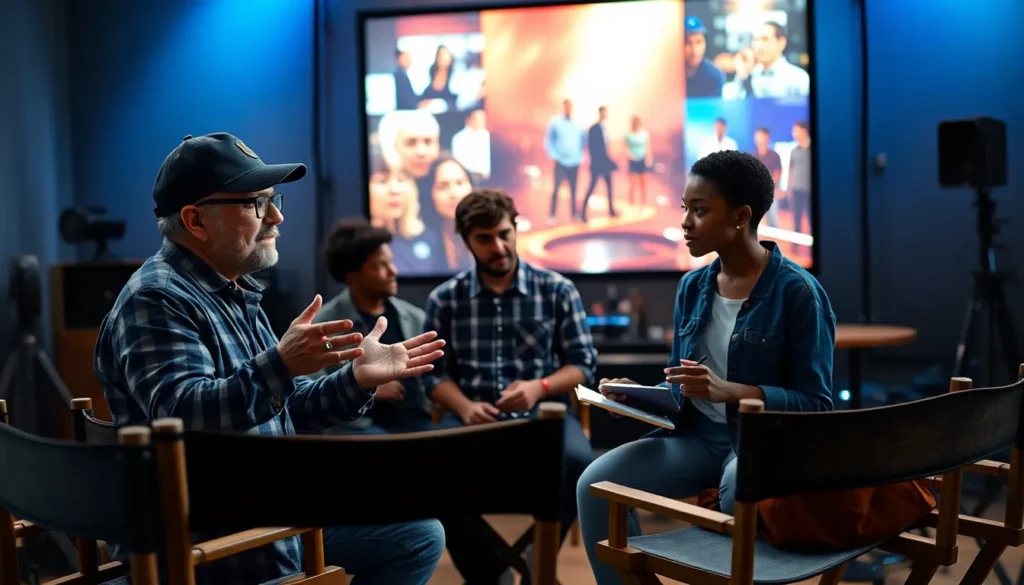Film narratives shape the way stories unfold on screen, captivating audiences and evoking emotions. From traditional linear plots to complex non-linear storytelling, filmmakers have pushed the boundaries of narrative structure. This exploration reveals how different techniques influence audience engagement and interpretation.
Understanding film narrative is crucial for both creators and viewers. It not only enhances appreciation for cinematic art but also uncovers deeper meanings hidden within the visuals. As narratives evolve, they reflect cultural shifts and societal issues, making films a powerful medium for storytelling. Whether through character development, thematic depth, or innovative structures, the journey of film narrative offers endless possibilities for exploration and discussion.
Table of Contents
ToggleOverview of Film Narrative Exploration
Film narrative exploration involves analyzing the ways stories unfold in cinema. This study reveals the techniques filmmakers employ to engage audiences and convey themes.
Definition and Importance
Film narrative refers to the structured way stories are told through moving images and sound. It encompasses elements such as plot, character, and conflict, allowing filmmakers to communicate ideas effectively. Understanding film narratives enhances viewers’ ability to interpret motivated actions and underlying themes. This comprehension fosters a richer appreciation of character complexity and emotional engagement, ultimately deepening the cinematic experience.
Historical Context
Film narratives have evolved from silent films with straightforward plots to complex, layered storytelling. Early cinema relied on linear progression, often driven by dialogue and visual cues. As technology advanced and audiences sought more sophisticated storytelling, filmmakers began experimenting with non-linear timelines and fragmented narratives. Movements such as German Expressionism and French New Wave challenged conventional structures, paving the way for the diverse narrative forms seen in contemporary films. The shift in narrative styles reflects broader cultural and societal changes, illustrating cinema’s role as a mirror to human experience.
Key Elements of Film Narratives

Film narratives rely on several key elements that shape how stories are conveyed, impacting audience engagement and understanding. Two essential components are character development and plot structure.
Character Development
Character development forms the heart of a film narrative. It involves creating multifaceted characters with distinct personalities, motivations, and growth arcs. Audiences connect with well-developed characters, as they reflect their own experiences and emotions. Techniques such as backstory, dialogue, and visual portrayal enhance character depth. Crucially, character relationships and conflicts propel the narrative forward, revealing themes and driving viewer empathy. Iconic films often showcase character transformation, illustrating how experiences shape identities and decisions, further enriching the storytelling.
Plot Structure
Plot structure organizes a film’s narrative flow, determining how events unfold. Traditional structures often follow a three-act format: setup, confrontation, and resolution. This framework allows filmmakers to establish context, build tension, and deliver satisfying conclusions. However, contemporary films frequently experiment with non-linear storytelling, employing flashbacks, multiple perspectives, or fragmented timelines. These approaches create intrigue and challenge audiences to actively engage in the narrative. A well-crafted plot structure not only serves the storyline but also enhances thematic elements, allowing filmmakers to explore complex ideas within a coherent framework.
Techniques in Film Narrative Exploration
Film narrative employs various techniques to enhance storytelling and engage audiences. These methods include non-linear storytelling and the use of flashbacks, each serving distinct purposes.
Non-Linear Storytelling
Non-linear storytelling disrupts the chronological flow of a narrative. Films utilizing this approach often present events out of order, allowing viewers to piece together the story. This technique can create suspense and intrigue, as seen in films like Pulp Fiction and Memento. Non-linear narratives often reflect complex character motivations and themes, inviting audiences to actively interpret the plot. The structure invites reflection on cause and effect, making the viewing experience more dynamic.
Use of Flashbacks
Flashbacks provide essential context and depth to character arcs and plot development. This technique allows filmmakers to reveal past events that shape characters’ present actions and decisions. Effective flashbacks enhance emotional impact, offering insights into motivations and conflicts. Films like The Godfather Part II and Eternal Sunshine of the Spotless Mind exemplify how flashbacks can intertwine with the main narrative, enriching the overall story. By strategically placing flashbacks, filmmakers guide viewers through timelines, fostering a deeper connection to the characters and their journeys.
Case Studies in Film Narrative
Film narratives provide diverse storytelling experiences. Several iconic films exemplify how narrative structures shape viewer engagement and thematic depth.
Iconic Films and Their Narratives
- Citizen Kane: Utilizes a non-linear narrative, revealing Charles Foster Kane’s life through multiple perspectives. This structure enhances the mystery surrounding his character.
- Pulp Fiction: Features interwoven storylines that challenge conventional chronology. Events unfold in a fragmented manner, prompting audiences to piece together the narrative.
- The Godfather: Employs a traditional three-act structure while exploring themes of power and family. Character arcs develop steadily, deepening audience connections.
- Eternal Sunshine of the Spotless Mind: Uses a non-linear approach to depict the complexities of memory and love. Flashbacks intertwine with present-day events, enhancing emotional resonance.
- Inception: Plays with dream layers and time perception. The multi-layered narrative creates suspense and puzzles viewers, inviting deeper thinking about reality.
Comparative Analysis of Different Genres
- Drama: Often utilizes character-driven narratives. Filmmakers focus on character development and plot arcs, revealing emotional depth and thematic intricacies.
- Thriller: Frequently employs non-linear narratives and unreliable narrators. These elements build tension and suspense, keeping audiences engaged.
- Science Fiction: Uses complex narratives to explore speculative themes. Films like Blade Runner challenge viewers to reflect on identity and technology through innovative storytelling.
- Animation: While often straightforward, certain animated films use unique narrative techniques. For instance, Spirited Away blends fantasy with layered storytelling, appealing to both children and adults.
- Documentary: Utilizes a real-life narrative structure. Filmmakers often blend interviews, archival footage, and observational footage to construct compelling stories around actual events.
Film narratives vary widely across genres and styles. These case studies illustrate the richness of storytelling in cinema, enhancing both audience experience and thematic exploration.
Film narratives serve as a powerful lens through which audiences can explore complex themes and character journeys. By embracing both traditional and innovative storytelling techniques filmmakers create immersive experiences that resonate on multiple levels. The evolution of narrative structures not only reflects cultural shifts but also deepens viewers’ emotional connections to the stories being told.
As cinema continues to evolve filmmakers will likely push the boundaries of narrative exploration further. This ongoing journey invites audiences to engage more actively with films challenging them to think critically about the stories they consume. Ultimately the richness of film narrative exploration enhances appreciation for the art form and reinforces its significance in reflecting the human experience.





